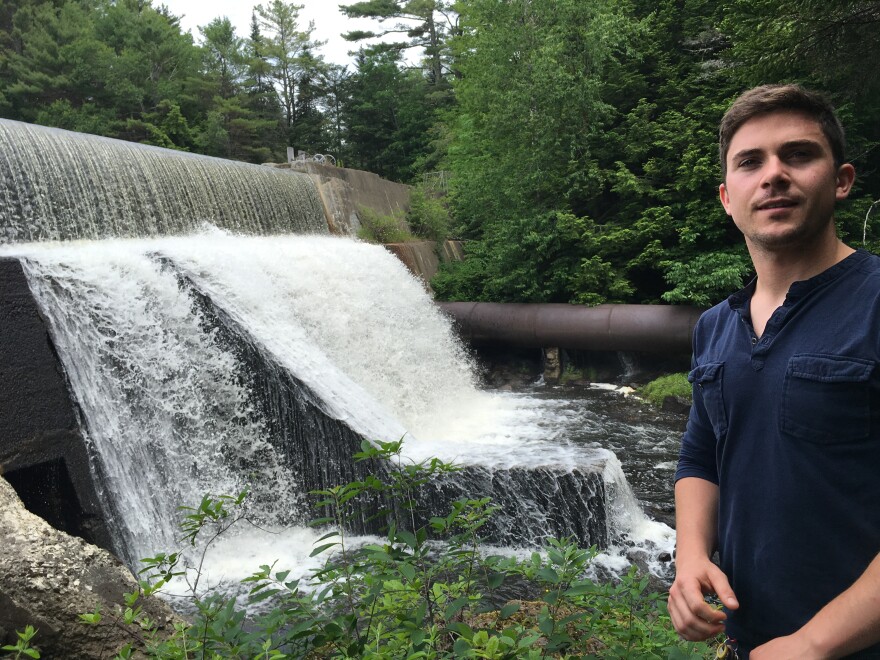Maine is home to hundreds of dams that have fallen out of use, a legacy of the heyday of its mills.
The dams can be a liability for owners and municipalities, who have to maintain them or pay for their removal, which in turn can upset people who’ve come to rely on their impoundments for recreation. But a couple of 20-something entrepreneurs sees potential in old dams in the form of renewable energy and profit.
The Goose River runs roughly nine miles from Swan Lake in Swanville to meet the sea in Belfast. Along the way, it passes through several dams and impoundments built more than a century ago to power a leather board mill, including one dam now owned by a company called Goose River Hydro.
“This is the original turbine — this turbine drove a big flywheel and belt pulley system that supplied mechanical power to the mill that was here,” says company co-founder Nick Cabral, a trim, 25-year-old marine engineer.
Cabral and business partner Nick Bernier have been working six years, since before they graduated from Maine Maritime Academy, to rehabilitate the river’s mouldering dams and bring them into service as hydroelectric plants. Right now, Cabral’s the sole occupant of a ramshackle mill building they’ve converted into living quarters. His partner is at sea, working the engine room of a tramp ship that’s headed to Cuba.
“And that’s kind of how we’ve been bootstrapping the company,” Cabral says. “We’ll go out to sea for three months and then we’ll come home for three months and just hammer it.”
Despite their youth, the partners believe their training, willingness to put in sweat equity and a $200,000 private loan could give them a chance in the energy industry.
“And we had just enough knowledge about electricity to be dangerous, and so we put all that stuff together and thought if we can fix a ship that’s bobbing around in the ocean we could probably fix a stationary piece of machinery,” Cabral says.
Mason’s Dam is a few miles upstream from the mill where Cabral lives. It’s small, maybe 15 feet tall, sloping down from a clear holding pool to the rock-strewn stream below.
“It’s a good example of a lot of the dams throughout Maine. Stone masonry. This facility was used to manufacture ax handles,” he says.
Now the dam manufactures electricity. At its base, a big, culvert-style, rust-colored tube called a penstock carries water from the dam down to the turbine system. Inside the powerhouse, Cabral shows off two turbine units built 30 years ago by a Camden machinist, which he and his partner rehabbed.

Painted blue, big as refrigerators and shaped like torpedoes, the turbines shake and rattle like a hardworking combustion engine. Although, of course, no fossil fuels involved.
“It’s the power of the river,” Cabral says. “Right now it’s producing between 35 and 48 kilowatts, and so that fluctuates based upon the water level of the head pond above.”
Cabral thinks of rain as “pennies from heaven” — the more water in the run-of-the-river system, the more energy to be captured and, under a 20-year contract approved by state regulators, sold to Central Maine Power at 10 cents per kilowatt hour. That’s above current spot-market rates, and you can add on another 20-40 percent for credits state policy provides to incentivize renewable energy generation.
Still, even going full-bore, these turbines alone would earn roughly $6 an hour, hardly enough to justify the heavy upfront acquisition, rehab and licensing costs Goose River Hydro is incurring. Which is where, a few miles downstream, a concrete dam comes in.
More than 200 feet wide and 20 feet tall, it’s the key to quadrupling the overall project’s capacity.
“This is definitely, I think, the gem of the project,” Cabral says.
The penstock at the dam’s base is designed to deliver some 40,000 cubic feet of water per second to a powerhouse below, although it’s not handling the gushing supply so well right now.
“It’s corroded so much, there’s all these little pinhole leaks all over the penstock itself. You have some larger holes, which is where you see all that water coming through from constant erosion,” Cabral says.
He estimates it will take half a million dollars to rehab and retrofit this part of the system. The plan is to have that work completed by 2020, when federal regulators will decide whether to authorize a new long-term operating license.

Dam recertification can be controversial, with some river advocates calling for their removal or the installation of expensive fish ladders. Cabral says he believes in ecosystem protection, and the company is researching relatively inexpensive means of helping fish get upstream, should federal or state regulators require it.
He is working on other innovations too. Cabral and another partner have started a company, Surge Hydro, which — if its patents are approved, and work — would allow municipal and private owners of small, out-of-service dams to retrofit them quickly and cheaply, ideally creating enough electricity to at least pay for their maintenance.
Cabral says he imagines attracting a cadre of young engineers to Maine to do the work.
“With our growing old population, we’ve got to figure out a way to keep people in Maine and keep our economy moving forward. And hydropower is one of those good ways to do it and also play nice with the environment at the same time — and Maine has the resource,” he says.
One turning point is coming soon: Goose River Hydro is seeking to retire that initial loan it took out. It’s aiming to refinance through a commercial bank, an important marker in the company’s future viability.
Cabral estimates that once the project is fully stood up, it should net annual revenues of $120,000 a year and maybe more.
This report comes from the New England News Collaborative: Eight public media companies coming together to tell the story of a changing region, with support from the Corporation for Public Broadcasting.



